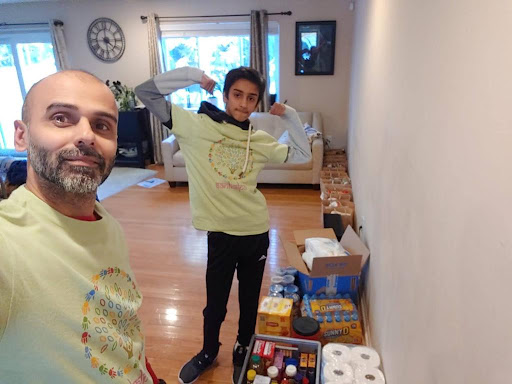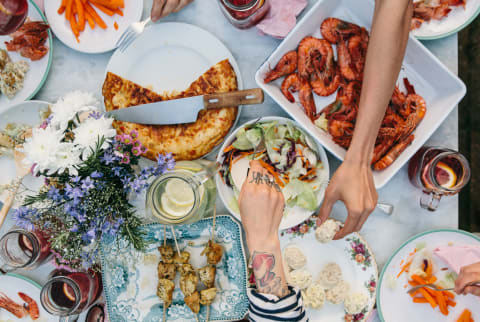Food waste does not seem fair.
The truth is, we are seeing a widening disparity of resources in the world today. However, when I see this gap growing, especially when it comes to food, it becomes harder to accept.
I spent the first 6 years of my life in India. The city was growing, which attracted many migrants to the city. While waiting for my school bus every morning, I would see little kids like me, living in makeshift tents, while their parents looked for work on the many construction sites. It became obvious that these kids were malnourished and went to sleep hungry on most days.
Recently in the US, due to the global pandemic, many families were affected economically. A few families in our community (mine included) got together to collect donations for the local food pantry. The response was overwhelming. This got me thinking about the number of people we could feed.

My dad and I ready to distribute food to families in our local food pantry.
The opportunity is huge
Hunger, especially among children, is a global phenomenon. 60% of children from low-income families come to school hungry. Right now, in the United States, the numbers don’t look so good. In 2020, 38.3 million people alone suffered from food insecurity. Over 42 million Americans face hunger every day including 1 in 6 children. This results in a lag of social, emotional, and cognitive skills.
It broke my heart. As I realized my growing concern, I remembered the one thing my parents taught me early in my life: Action is a powerful way to overcome stress, and if there is anything you can do about what makes you passionate, then do it. It is out of this furnace of stress and desire to do something that Foodtopia was born.
The opportunity is huge, there is a lot of food surplus right now and a lot of it goes to waste. 85% of unused food in a typical American restaurant is thrown away and dug into landfills creating methane and polluting the environment. If only there was a way to bridge the gap.
Foodtopia: a simple solution
The service I wish to create, Foodtopia, will act as the bridge between food surplus and hunger. It will be a platform where local restaurants with excess food and individual donors are connected with local Food Pantries and Soup Kitchens through a map on my website. Food will be transported between restaurants and pantries using partnerships with Uber, Doordash, grubhub, and other organizations like Move for Hunger. The donors will undergo certifications to ensure the quality of food is good.
There is a huge demand for a service like this as I realized when I spoke with the owner of our local Panera. They donate excess food to local churches every day but that is purely through personal contacts. Therefore, their efforts are not scaled up. Imagine the multiplier effect a service like this would cause in every community.
The real strength of Foodtopia is its simplicity. It is a map that answers simple questions about food:
- I have excess food. Show me who needs it near me?
- I need food. Show me who has it near me?
A challenge for today’s youth
There is a lot at stake for the world, but more for the next generation. That is why we need today’s youth to battle hunger and food waste. This is a cause I believe today’s youth like myself are passionate about because it directly affects our future. Working together with high school students, Boy Scout Troops, and community organizations, I will create a movement that will address this urgent issue of growing hunger and poverty.
There is a long way to go, but we need to start somewhere.
I believe that the Foodtopia model – by working with restaurants and individual donors and connecting them with shelters and food pantries in an efficient manner – can create a huge impact and can be easily replicated worldwide. It is my dream to go back to India and use a platform like Foodtopia to help the fight against food insecurity for families like those I witnessed every day while going to school.








